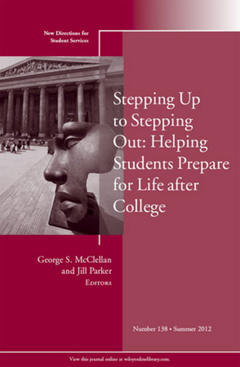Description
Stepping Up to Stepping Out: Helping Students Prepare for Life After College
New Directions for Student Services, Number 138
J–B SS Single Issue Student Services Series
Coordinators: McClellan George S., Parker Jill
Language: English
116 p. · 15.2x22.7 cm · Paperback
Description
/li>Contents
/li>
Undergraduate students come to college from a myriad of pathways for a variety of purposes, and the same can be said of them as they leave to head off into their next endeavors. Arguably, the most important goal of higher education is to prepare students to achieve their postcollege aspirations, and campuses typically pursue that goal through a combination of curricular and co–curricular programs and services for students.
This issue offers readers a glimpse into contemporary context and practice related to helping students with their after–college transition from one form of education (two–year or four–year) to the next (four–year, graduate, or professional school), from education to workforce, or from education to military service.
This is the 138th volume of this Jossey–Bass higher education quarterly series. An indispensable resource for vice presidents of student affairs, deans of students, student counselors, and other student services professionals, New Directions for Student Services offers guidelines and programs for aiding students in their total development: emotional, social, physical, and intellectual.
George S. McClellan and Jill Parker
1. Preparing Students for After–College Life: The Context 5
Kelli K. Smith
This chapter addresses the context in which student affairs professionals, faculty, and other mentors prepare students for after–college life.
2. Engaging Theories and Models to Inform Practice 13
Amanda Kraus
This chapter explores theories and models that can inform student affairs practitioners and faculty in preparing students for life after college.
3. Pathway Programs to Life after College 29
Jim F. McAtee
Programs are one avenue for preparing students for after–college life. General principles, theories, and examples of such programs are discussed here.
4. Four Programmatic Approaches to Assisting Students′ Transition from College 43
Amy Diepenbrock and Wanda Gibson
This chapter describes four programs designed to assist students in the transition to after–college life.
5. Overview of Curricular Approaches 59
Cameo V. Hartz and Jill Parker
Institutions use both programmatic and curricular approaches to address students′ transition to life after college. While Chapter Four discusses the programmatic approaches, this chapter provides an overview of the curricular approaches.
6. Case Studies of Curricular Approaches 75
Ann G. Mills and Janice Sutera
This chapter provides an overview of the career courses adapted by three universities to support the career transition process for each of their student populations. Each university varies by size, location, student population, and approach in the support of the career development needs of their students.
7. Looking Forward: New Challenges and Opportunities 91
Elizabeth J. Bushnell
This chapter looks ahead to consider how changes in higher education and other social arenas might offer challenges and opportunities that can inform how student affairs practitioners and faculty colleagues assist students in preparing for after–college life.
INDEX 105




